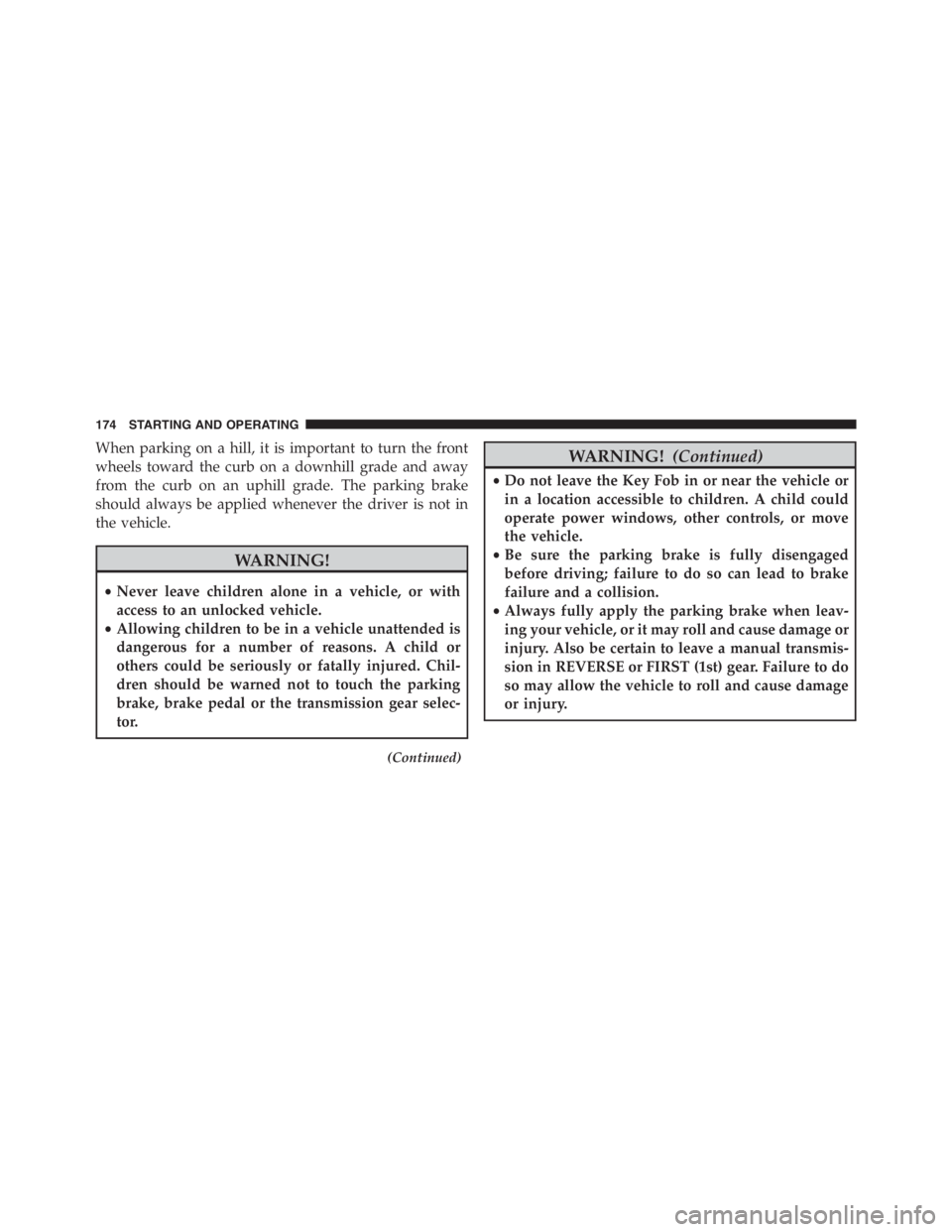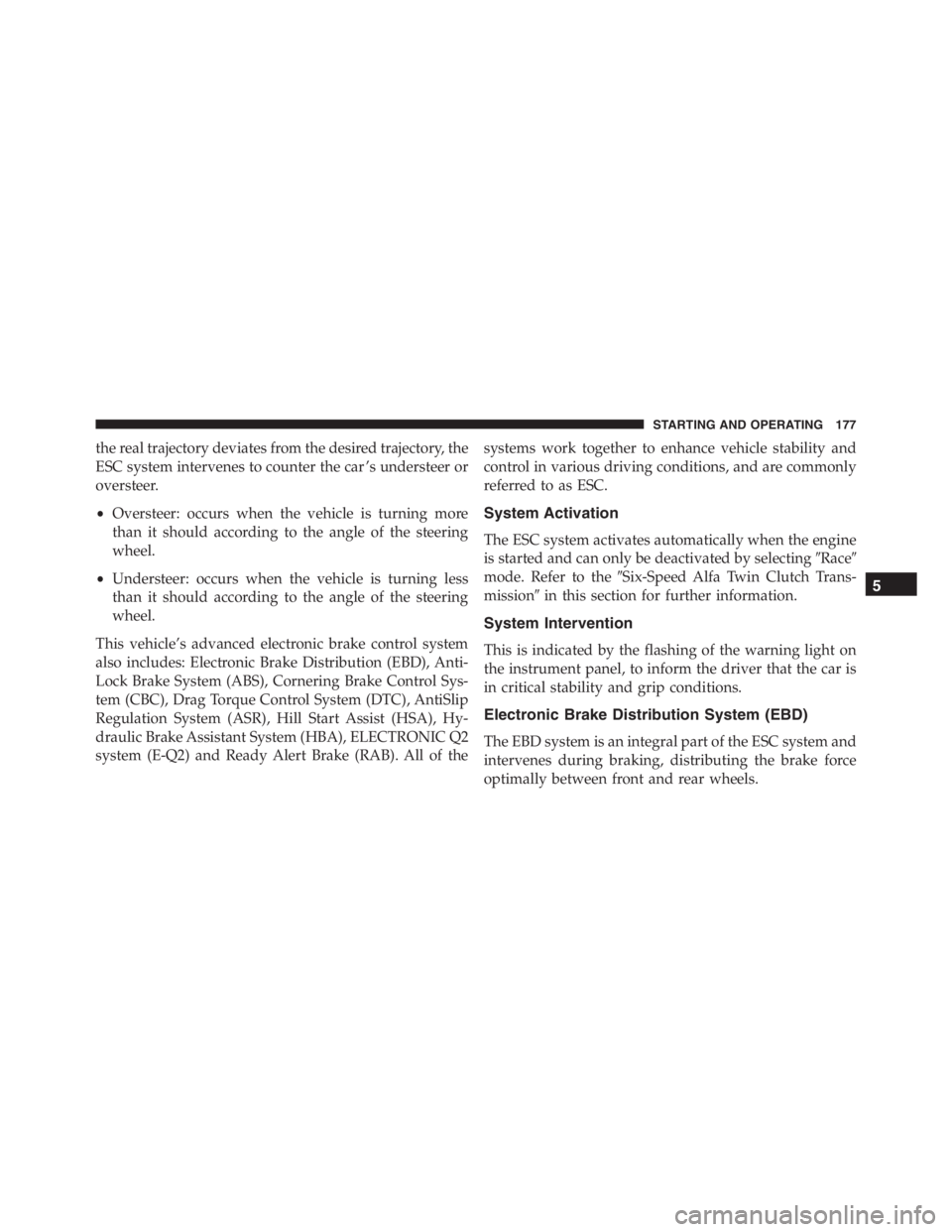Page 173 of 348

Flowing/Rising Water
WARNING!
Do not drive on or across a road or path where water
is flowing and/or rising (as in storm run-off). Flow-
ing water can wear away the road or path’s surface
and cause your vehicle to sink into deeper water.
Furthermore, flowing and/or rising water can carry
your vehicle away swiftly. Failure to follow this
warning may result in injuries that are serious or
fatal to you, your passengers, and others around you.
Shallow Standing Water
Although your vehicle is capable of driving through
shallow standing water, consider the following Cautions
and Warnings before doing so.
WARNING!
•Driving through standing water limits your vehi-
cle’s traction capabilities. Do not exceed 5 mph
(8 km/h) when driving through standing water.
•Driving through standing water limits your vehi-
cle’s braking capabilities, which increases stopping
distances. Therefore, after driving through stand-
ing water, drive slowly and lightly press on the
brake pedal several times to dry the brakes.
•Failure to follow these warnings may result in
injuries that are serious or fatal to you, your pas-
sengers, and others around you.
5
STARTING AND OPERATING 171
Page 175 of 348
PARKING BRAKE
Before leaving the vehicle, make sure that the parking
brake is fully applied. Also, be certain to leave manual
transmission in REVERSE (R) or FIRST (1st) gear.
The parking brake lever is located in the central tunnel.
To apply the parking brake, pull the parking brake lever
up as firmly as possible. To release the parking brake,
pull the parking brake lever up slightly, press the center
button, then lower the parking brake lever completely.
When the parking brake is applied with the ignition
switch in the MAR (ACC/ON/RUN) position, the Brake
Warning Light in the instrument cluster will illuminate.
Parking Brake Lever
5
STARTING AND OPERATING 173
Page 176 of 348

When parking on a hill, it is important to turn the front
wheels toward the curb on a downhill grade and away
from the curb on an uphill grade. The parking brake
should always be applied whenever the driver is not in
the vehicle.
WARNING!
•Never leave children alone in a vehicle, or with
access to an unlocked vehicle.
•Allowing children to be in a vehicle unattended is
dangerous for a number of reasons. A child or
others could be seriously or fatally injured. Chil-
dren should be warned not to touch the parking
brake, brake pedal or the transmission gear selec-
tor.
(Continued)
WARNING!(Continued)
•Do not leave the Key Fob in or near the vehicle or
in a location accessible to children. A child could
operate power windows, other controls, or move
the vehicle.
•Be sure the parking brake is fully disengaged
before driving; failure to do so can lead to brake
failure and a collision.
•Always fully apply the parking brake when leav-
ing your vehicle, or it may roll and cause damage or
injury. Also be certain to leave a manual transmis-
sion in REVERSE or FIRST (1st) gear. Failure to do
so may allow the vehicle to roll and cause damage
or injury.
174 STARTING AND OPERATING
Page 177 of 348

CAUTION!
If the Brake Warning Light remains on with the
parking brake released, a brake system malfunction
is indicated. Have the brake system serviced by an
authorized dealer immediately.
BRAKE SYSTEM
Your vehicle is equipped with dual hydraulic brake
systems. If either of the two hydraulic systems loses
normal capability, the remaining system will still func-
tion. However, there will be some loss of overall braking
effectiveness. You may notice increased pedal travel
during application, greater pedal force required to slow
or stop, and potential activation of the “Brake System
Warning Light.”In the event power assist is lost for any reason (i.e.,
repeated brake applications with the engine off) the
brakes will still function. However, the effort required to
brake the vehicle will be much greater than that required
with the power system operating.
ESC (ELECTRONIC STABILITY CONTROL)
SYSTEM
The ESC system improves the directional control and
stability of the vehicle in various driving conditions.
The ESC system corrects the car ’s understeer and over-
steer, distributing the brake force on the appropriate
wheels. The torque supplied by the engine can also be
reduced in order to maintain control of the car.5
STARTING AND OPERATING 175
Page 178 of 348

WARNING!
•Electronic Stability Control (ESC) cannot prevent
the natural laws of physics from acting on the
vehicle, nor can it increase the traction afforded by
prevailing road conditions. ESC cannot prevent all
collisions, including those resulting from excessive
speed in turns, driving on very slippery surfaces, or
hydroplaning. ESC also cannot prevent collisions
resulting from loss of vehicle control due to inap-
propriate driver input for the conditions. Only a
safe, attentive, and skillful driver can prevent col-
lisions.The capabilities of an ESC equipped ve-
hicle must never be exploited in a reckless or
dangerous manner which could jeopardize the us-
er ’s safety or the safety of others.
(Continued)
WARNING!(Continued)
•Vehicle modifications, or failure to properly main-
tain your vehicle, may change the handling charac-
teristics of your vehicle, and may negatively affect
the performance of the ESC system. Changes to the
steering system, suspension, braking system, tire
type and size or wheel size may adversely affect ESC
performance. Improperly inflated and unevenly
worn tires may also degrade ESC performance. Any
vehicle modification or poor vehicle maintenance
that reduces the effectiveness of the ESC system can
increase the risk of loss of vehicle control, vehicle
rollover, personal injury and death.
The ESC system uses sensors installed on the car to
determine the trajectory that the driver intends to follow
and compares it with the car ’s effective trajectory. When
176 STARTING AND OPERATING
Page 179 of 348

the real trajectory deviates from the desired trajectory, the
ESC system intervenes to counter the car ’s understeer or
oversteer.
•Oversteer: occurs when the vehicle is turning more
than it should according to the angle of the steering
wheel.
•Understeer: occurs when the vehicle is turning less
than it should according to the angle of the steering
wheel.
This vehicle’s advanced electronic brake control system
also includes: Electronic Brake Distribution (EBD), Anti-
Lock Brake System (ABS), Cornering Brake Control Sys-
tem (CBC), Drag Torque Control System (DTC), AntiSlip
Regulation System (ASR), Hill Start Assist (HSA), Hy-
draulic Brake Assistant System (HBA), ELECTRONIC Q2
system (E-Q2) and Ready Alert Brake (RAB). All of thesystems work together to enhance vehicle stability and
control in various driving conditions, and are commonly
referred to as ESC.
System Activation
The ESC system activates automatically when the engine
is started and can only be deactivated by selecting�Race�
mode. Refer to the�Six-Speed Alfa Twin Clutch Trans-
mission�in this section for further information.
System Intervention
This is indicated by the flashing of the warning light on
the instrument panel, to inform the driver that the car is
in critical stability and grip conditions.
Electronic Brake Distribution System (EBD)
The EBD system is an integral part of the ESC system and
intervenes during braking, distributing the brake force
optimally between front and rear wheels.
5
STARTING AND OPERATING 177
Page 180 of 348

This guarantees greater braking stability for the vehicle,
preventing sudden locking of the rear wheels and the
consequent instability of the vehicle.
Four-Wheel Anti-Lock Brake System (ABS)
The Four-Wheel ABS is designed to aid the driver in
maintaining vehicle control under adverse braking con-
ditions. The system operates with a separate computer to
modulate hydraulic pressure, to prevent wheel lock-up
and to help avoid skidding on slippery surfaces.
The system’s pump motor runs during an ABS stop to
provide regulated hydraulic pressure. The pump motor
makes a low humming noise during operation, which is
normal.
The ABS includes an amber ABS Warning Light. When
the light is illuminated, the ABS is not functioning. The
system reverts to standard non-anti-lock brakes. Turningthe ignition Off and On again may reset the ABS if the
fault detected was only momentary.
WARNING!
•When the ABS intervenes and you feel the brake
pedal pulsating, do not reduce the pressure, but
hold it down firmly and confidently; in doing so
you will brake in the shortest distance possible,
depending on the current road conditions.
•For maximum efficiency of the braking system, a
bedding-in period of about 311 miles (500 km) is
required: during this period it is advisable to avoid
sharp, repeated and prolonged braking.
•If the ABS intervenes, this indicates that the grip of
the tires on the road is nearing its limit: you must
slow down to a speed compatible with the avail-
able grip.
(Continued)
178 STARTING AND OPERATING
Page 181 of 348

WARNING!(Continued)
•The ABS can’t overrule the natural laws of physics,
and can’t increase the grip available according to
the condition of the road.
•The ABS cannot prevent accidents, including those
due to excessive speed on corners, driving on
low-grip surfaces or aquaplaning.
•The capability of the ABS must never be tested
irresponsibly and dangerously, in such a way as to
compromise personal safety and the safety of oth-
ers.
•For the correct operation of the ABS, the tires must
of necessity be the same make and type on all
wheels, in perfect condition and, above all, of the
prescribed type and dimensions.When you are in a severe braking condition involving the
use of the ABS, you will experience some pedal drop as
the vehicle comes to a stop. This is the result of the
system reverting to the base brake system.
Engagement of the ABS may be accompanied by a
pulsing sensation. You may also hear a clicking noise.
These occurrences are normal and indicate that the
system is functioning properly.
System Intervention
A slight pulsing of the brake pedal and noise indicates
the intervention of the ABS: this is completely normal
when the system intervenes.
5
STARTING AND OPERATING 179